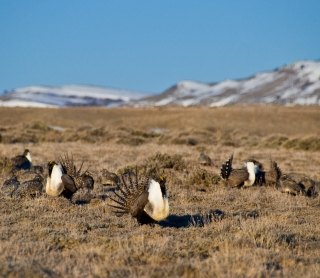According to the U.S. Fish and Wildlife Service, Wyoming is home to 37 percent of all sage-grouse found in the United States. Habitat fragmentation, land development, energy infrastructure, invasive plants, fire, predation, and climate change have been cited as threats to the species and their sagebrush-dominated habitat.
The greater sage-grouse (Centrocercus urophasianus) inhabits sagebrush country throughout the western United States and two provinces in Canada. Increasingly, sage-grouse are becoming one of the largest environmental concerns that project developers and management agencies face in sagebrush country throughout the Rocky Mountains, Great Basin, and Pacific Northwest. Even with the U.S. Fish and Wildlife Service’s decision to not add the bird to the Endangered Species List, it is expected that regulatory uncertainty will continue as state and federal management plans are finalized and implemented.
States are leading efforts across the range of the species to find conservation approaches and plans that will minimize the impact of development on the bird. Wyoming and Montana have developed core area policies that limit the amount of new surface disturbance in areas identified for sage-grouse conservation. Other states such as Utah, Colorado, Idaho, and Nevada have, or are developing, similar habitat conservation and mitigation approaches. The goal of these efforts is to conserve and protect sage-grouse while balancing the need for activities such as energy development that occur in the species’ range.
Sage-grouse Monitoring and Research
South-central Wyoming is the site of one energy project where the developer has implemented extensive measures to conserve greater sage-grouse: the proposed Chokecherry and Sierra Madre (CCSM) Wind Energy Project. In 2009, SWCA biologists began modeling habitat and monitoring sage-grouse populations to help Power Company of Wyoming LLC (PCW) identify how the birds are using the landscape within the proposed project area. The objectives of this effort are to evaluate the response of sage-grouse behavior and populations to the wind project once it is operational, site the project in an environmentally responsible manner, and quantify the benefits of the many conservation measures that PCW and the landowner are implementing.
To accomplish these objectives, PCW is implementing an unprecedented evaluation of greater sage-grouse behavior and ecology. For more than five years, SWCA crews have been monitoring birds surrounding the CCSM Project area using solar-powered GPS transmitters attached to the backs of female sage-grouse. Between four and eight GPS locations are recorded per bird per day, relayed to the Argos satellite system, and downloaded to SWCA’s sage-grouse database management system. The information gained through the female grouse monitoring effort is supplemented by a parallel study of male sage-grouse funded by the National Wind Coordinating Collaborative and Wyoming Game and Fish Department. Partners in the male study include the University of Missouri, U.S. Forest Service Rocky Mountain Research Station, Wyoming Game and Fish Department, PCW, and SWCA.
The monitoring and research efforts were designed as a before-after control-impact study. Data collected prior to project construction will be compared to data collected during project construction and operations to evaluate the response of the species to wind energy activities. The project will monitor how the birds’ behavior may change and use the control-impact groups to evaluate the response of sage-grouse and determine any differences in patterns of habitat use, survival, behavior, and other population characteristics.
Identifying Patterns of Use
To date, the monitoring and research program has collected more than 500,000 sage-grouse GPS locations — an unprecedented amount of data that offer great insights into how the birds move about on the land. This is the largest known project-specific research and monitoring effort undertaken to characterize greater sage-grouse response to energy development. The tags provide data that have never been collected before — information that in turn is greatly adding to the scientific body of knowledge about the species. The resulting data over so many years of study are helping to identify important areas used by the birds at different times — lekking, nesting, brood-rearing, and during winter — and even movement corridors between different seasonal habitats.
Monitoring across approximately 750,000 acres has revealed interesting patterns of use by the species. For example, individuals and the entire population revisit the same patches of sagebrush and same movement corridors year after year, providing valuable data to inform project siting decisions and reduce potential impacts to the species. The datasets also enable science-based conservation measures to be implemented in locations that will immediately benefit sage-grouse populations and habitats. Many of these measures have already been put into place. To date, 17 miles of fences have been marked and 10 miles of fences have been removed to prevent potential collisions and mortality of sage-grouse. Additionally, enhanced grazing management, wildfire rehabilitation, and brood-habitat enhancement activities have been completed.
More Uses for the Data
The “after” part of the sage-grouse study will occur once project construction and operation commences. The response of sage-grouse to wind energy development activities will be monitored during and after construction to fully understand — and not just predict — the impacts of wind energy development. Without the CCSM Project, this important species research would never have been completed, nor would we have the robust sage-grouse information we now have.
In addition to using science to avoid, minimize, and mitigate impacts to the species from this project, data from these studies will help regulatory agencies and proponents of other land and energy development projects understand how sage-grouse respond to energy development activities. Through its collaborative approaches with agencies, researchers, academics, species experts, landowners, and other stakeholders, the CCSM Project is positive proof of how collaboration, transparency, and sound science can help create a project that is smart from the start.
